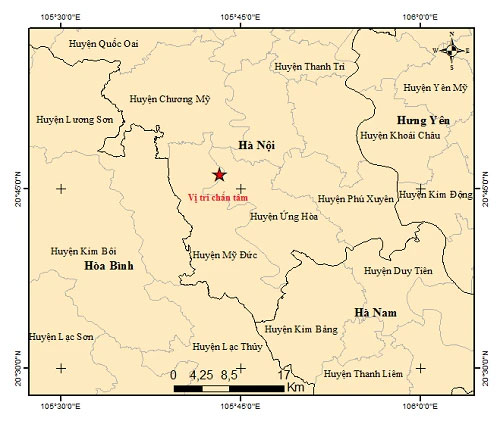An earthquake of magnitude 4 occurred, causing shaking in many areas in Hanoi
On the morning of March 25, people in some areas of My Duc district (Hanoi city) said they felt strong shaking, suspected to be caused by aftershocks of the earthquake.
Clip recorded the moment of the earthquake. (Source: MXH).
In some inner-city districts such as Cau Giay, Ha Dong, Thanh Xuan, people also clearly felt the shaking phenomenon occurring 2-3 times consecutively.
Talking to a reporter from VietnamPlus Electronic Newspaper about the above information, expert Nguyen Xuan Anh - Director of the Institute of Geophysics (Vietnam Academy of Science and Technology) said that the above shaking symptoms are due to excess energy. The impact of a magnitude 4 earthquake recently occurred in My Duc district, Hanoi city.

Map of the epicenter of the earthquake that occurred in My Duc district, Hanoi city. (Source: Institute of Geomatics).
According to expert Nguyen Xuan Anh, the above earthquake occurred at 8:05 a.m. this morning, March 25 . The focal depth of the earthquake is about 16km.
The Director of the Institute of Geophysics also noted that earthquakes below 5 degrees are generally considered small earthquakes, rarely causing natural disaster risks.
Earthquakes of 5-6 degrees or higher are medium earthquakes and pose a risk of natural disasters. From 6 or higher is a major earthquake, the risk of natural disasters is very high.
According to regulations, people's committees at all levels, when receiving news of an earthquake or tsunami warning, must in any form notify the above information to people in the area; Organize evacuation instructions and mobilize means in the area to help people evacuate to a safe place; ensure regional security and order.
For people, when receiving news of an earthquake or tsunami warning, all citizens in the affected area must proactively evacuate from dangerous areas to ensure safety.
Currently, the Earthquake Information and Tsunami Warning Center is still monitoring the developments of a magnitude 4 earthquake in the My Duc district area, to promptly notify the mass media and local authorities. direction.
In another development, sharing with reporters of VietnamPlus Electronic Newspaper, Associate Professor - Dr. Cao Dinh Trieu - Vice President of Vietnam Geophysical Science and Technology Association (Director of Institute of Applied Geophysics) said It is known that Hanoi is located in the Red River-Chay River fault zone , where earthquakes with magnitudes of 5.1-5.5 have occurred.
Normally, the recurrence period of a 5.3 earthquake in Hanoi city is 1,100 years and the last strong earthquake occurred more than 700 years ago (1285).
However, Mr. Trieu also noted that Hanoi is an area with poor ground, so there is also a risk of level 8 earthquakes. The reason is because if an earthquake occurs in the Red River-Chay River fault zone (this earthquake zone passes through Hanoi city) with maximum data recorded by monitoring stations at level 6, the possibility of impact is high. Movement in nature can also reach level 8.
'Therefore, if an earthquake occurs in Hanoi, it will cause major shocks. As long as there is an earthquake with a magnitude above 4, old apartment buildings and old, degraded dormitories in the city will not be able to withstand it,' Mr. Trieu emphasized.
According to Mr. Trieu, in addition to the risk of a major earthquake, the Hanoi area is also an area with poor ground, so it is easy to feel tremors when there is a major earthquake elsewhere. In recent times, reality shows that Hanoi has experienced shaking due to the impact of aftershocks from neighboring countries such as Laos and China.
Most recently, at about 8:43 p.m. on December 24, 2021, many people living in high-rise buildings in Hanoi felt strong shaking. The cause was later determined to be the impact of a 5.5 magnitude earthquake in Laos.
Besides earthquake aftershocks from abroad , in recent years, a series of stimulating earthquakes have also occurred in many localities across the country. Even in history, in Vietnam there was also a strong earthquake of up to 6.9 in the Dien Bien basin (in 1935). Therefore, according to Mr. Trieu, the impact of aftershocks from major earthquakes occurring in the country is also a potential risk.
From the above reality, Mr. Trieu believes that in the coming time, Vietnam in general and Hanoi in particular need to pay more attention to seismic resistance for construction projects, especially for residential projects (like general high-rise buildings,.) to ensure safety as well as minimize potential risks that may occur and affect people.
'I think that coming here we need to pay attention to consolidating and re-establishing the network of earthquake monitoring stations in Hanoi. This is very important, because recently, every earthquake that occurs remotely causes many buildings to shake, possibly because the foundations of buildings in Hanoi are a bit weak,' Mr. Trieu shared. .
- Hanoi Building shook because of the continuous earthquake in Son La
- Earthquake in Hai Phong, Hanoi building shook
- Another 4-magnitude earthquake in Son La
- Southern Mexico was shaken by a powerful earthquake
- Strong earthquake in Afghanistan
- Find the culprit causing earthquakes in Iran
- Strong earthquake shakes Taiwan
- Nam Bo met with a magnitude 5.5 earthquake
- Hanoi sensed shaking due to earthquakes in Yunnan, China
- There was a 3-magnitude earthquake in Dien Bien
- The magnitude 6 earthquake shook Japan
- New earthquake cycle in Vietnam?
 Is the magnetic North Pole shift dangerous to humanity?
Is the magnetic North Pole shift dangerous to humanity? Washington legalizes the recycling of human bodies into fertilizer
Washington legalizes the recycling of human bodies into fertilizer Lightning stone - the mysterious guest
Lightning stone - the mysterious guest Stunned by the mysterious sunset, strange appearance
Stunned by the mysterious sunset, strange appearance